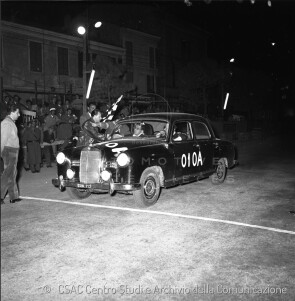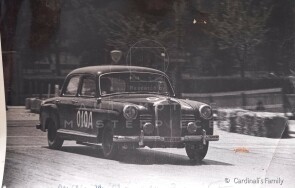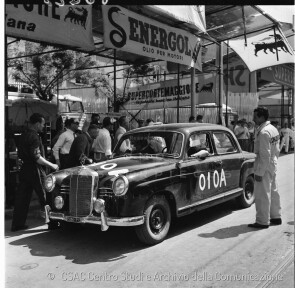
1954 Mercedes-Benz 180 D
ON/OFF
Why am I an Automotive Masterpiece?
The rebirth of Mercedes-Benz, after the war, will be marked by a body; in one word it was: "Ponton". This is a term that refers to a type of automotive body widespread in the post-war years, especially in Europe, from which the bodies of modern cars derive. The main characteristics that differentiated the Ponton-type bodywork from the previous ones were the absence of separated fenders from the car body and the lack of running boards or platforms; they therefore had a smooth and rounded side resulting from the integration of the fenders into the rest of the bodywork. In German, the word "Ponton" means flat-bottomed boat, for navigating shallow waterways; the Mercedes-Benz Ponton are the first Mercedes-Benz chassis with a flat floor. Pontons are all the Mercedes-Benz four-door sedans and the 220 S and SE coupés or cabriolets built between July 1953 and October 1962, with the chassis prefix W120, W121, W180, W105 and W128. The Mercedes-Benz Benz of the W120 and W121 families (the latter being a derivative of the former) are also the first Mercedes-Benz with a unibody. In fact, the classic separated X frame with oval section tubes was abandoned, in favor of the so-called platform, an almost new concept at the beginning of the 1950s and used at the time by only a few cars. The solution of the unibody structure demonstrated the German company's desire for renewal after the disastrous period of the Second World War. Likewise, the new Ponton-type bodywork was intended to be a way of looking forward also from a stylistic point of view, leaving behind the now anachronistic design of the pre-war 170V and 170S. The project for the Mercedes-Benz 180, the first model produced in the W120 family, dates back to 1951, but the car was presented in 1953. Two years to create such an innovative project was a short period, a sign of the German company's strong desire to return to be a reference point in the automotive sector. At its debut the 180 did not receive great acclaim, largely due to the new shape of its bodywork which the public was not used to and which was not appreciated by the more traditionalist customers: the 180 was modern and broke away from the past of pre-war production even if it was not, in any case, revolutionary. After the first difficulties, however, the 180 began to be appreciated: people liked its behavior on the road, the careful assembly and the reliability of the engine. The latter could not be defined as innovative, in fact it was the tested 1.8-liter M136 unit already fitted on the latest 170 V and 170 S; still equipped with side valves, it delivered 52 hp, allowing the car a maximum speed of almost 130 km/h. The engine was fixed to a subframe which also supported other components, such as the transmission, steering box and front end. The latter was independent with wishbones, anti-roll bar and coil springs. The rear was independent, but with oscillating axle shafts and coil springs. The braking system was hydraulic with four-wheel drum brakes. From 1955 the rear with oscillating axles gave way to an oscillating axle with central articulation, a solution already tested in racing and also on the road with the 220a. In 1956, the price of the 180 dropped from 9950 marks of 1953 to 8700 marks, and in 1957 there was a new and more substantial update: the 180b (W120B II) was born, fitted with a new, more modern and more powerful engine, the 65 hp 1.9 M121B IV, capable of pushing the car to a top speed of 135 km/h. This engine had already powered other slightly earlier models, namely the 190 SL of 1955 and the 190 of 1956; in the 180 this engine was detuned so as not to trigger a competition phenomenon within the range. Between 1961 and 1962 the 180b became the 180c, with few detail updates. In October 1962 the W120 series was discontinued. A total of 118,234 units were produced of the petrol-powered Mercedes-Benz 180s.
In February 1954, the diesel engine version was introduced, the 180 D (W120 I) which was equipped, in this case, with the old OM636 1.8-liter unit already mounted on the 170 DS. This engine had an overhead valve configuration, more modern than the petrol unit. Power delivery was smooth but modest, having only 40 hp, so performance was lower than that of the petrol model and the maximum speed (which however roughly coincided with the cruising speed) stopped at 110 km/h. Nonetheless, the 180 D met with great success, especially among those using the car as a professional device, such as great travelers and taxi drivers. In 1959 the 180 D was replaced by the 180 Db, with a slightly more powerful 43 hp engine, with similar performance. At the end of the 1950s, the diesel 180 managed to hold a large share of Mercedes-Benz production, thanks to its operating economy qualities, mainly due to much lower consumption than the corresponding petrol versions. The 180 D also had its "c" version and went out of production in 1962. The diesel-powered Mercedes-Benz 180s were more than their petrol-powered counterparts and a total of 152,983 units were produced. Of these, 116,485 were the 180 D, first series, from 1954 to 1959.
1954 Mercedes-Benz 180 D with chassis no. 120 110 4511348 is an exceptional and almost unique example among the many diesel-powered “Pontons” that made post-war history, not only in Germany. Popular as taxis and street cars, loved by great travelers and commercial agents, the 180Ds plied the streets of renascent Europe in fleets at the slow but tireless pace of their diesel engine. This very car, however, had a sporting history of the highest importance; the car, in fact, took part in 1955 in the XXII Mille Miglia, valid for the World Sports Car Championship. In the period before the war, especially due to the sanctions against the regime in Italy, the red arrow had already seen the creation of categories for cars powered by particular fuels other than petrol; possibly “autarchic”. Cars powered by methane, gas generating systems and various types of alcohol were registered in a specific category. In the 1955 edition, given the growing interest for diesel vehicles, the "Diesel Group" category was created. Mercedes-Benz, having returned to being an automotive giant, wanted to be present in all categories: from sports fighting for overall victory, to grand touring cars, to medium-sized ones, including diesel powered. Mercedes-Benz 180 D chassis no. 120 110 4511348 was on the starting line driven by the owner Arturo Masera and the co-driver Pasquale Cardinali. The car completed the entire route at an average speed of over 90 km/h (practically always flat out), arriving at the end of the race and qualifying 220th overall. It also qualified third of only eight cars entered in the "Diesel Group" category, made up of four Fiat 1400 Diesels and four Mercedes-Benz 180 Ds, and was preceded by a few positions only by the two 180 Ds driven by German crews, supported by the parent company. Masera – Cardinali was the first among the Italian crews with “Diesel Group” cars. Cardinali, in a post-race interview declared himself satisfied with the result; he only complained about a brake failure after Chieti, which forced the crew to behave more prudently than hoped. Of the eight diesel racers, only one car withdrew but none of the 180 Ds, reaffirming the reliability of diesel-powered cars: perhaps not very fast but unstoppable. The category reserved for diesel cars in the Mille Miglia existed only that year; for this reason, the third place achieved by “our” car has an absolute value. The owner-driver, Arturo Masera, an industrialist from Piacenza and a passionate gentleman driver, was participating in the Mille Miglia for the first time, while his expert co-driver Cardinali was participating for the fifth time. Cardinali was the natural choice for Masera, since he was a sort of automotive mentor for him, having even given him sports driving lessons. Cardinali has always worked in the automotive field, but this would be an understatement; he was responsible for the ACI of Piacenza in wartime and was director of the ACI of Fiorenzuola d'Arda. He participated in several car and motorcycle competitions and organized many of them around the mid-1950s, such as Cortemaggiore Merano, Tizzano, Bobbio-Penice, Cortemaggiore Sanremo; he was also one of the creators of Castell'Arquato - Vernasca. He founded a racing driving school well ahead of his time and held theoretical lessons in his office in Piazza Garibaldi in Fiorenzuola d'Arda and practical tests on the road leading to Vernasca. The sporting history of the car was sensational and short as far as we know today: the 180 D chassis no. 120 110 4511348 changed ownership in 1958 and the following year was purchased by Eduardo Solimene, wealthy owner of an agricultural estate still active today in the Salerno area. The car therefore found itself in a most suited role to it, as a quiet, "respectable" tourer. From 1961 to 1966 the car was owned by a well-known one: Walter Zappolini, an étoile dancer and choreographer with long and prestigious experience, known to most for being Silvana Mangano's partner in the 1954 film “Mambo”. Above all, Zappolini founded and became Artistic Director of the Balletto di Roma company. It is easy to assume that the Mercedes was his companion on long tours around Europe. He was followed by several other owners who, however, treated the 180 D with care and respect; the car therefore arrived matching numbers and preserved up to the present day, when we traced its incredible past of its early days. It is the only survivor of its diesel category in the 1955 race, with an Italian crew.





